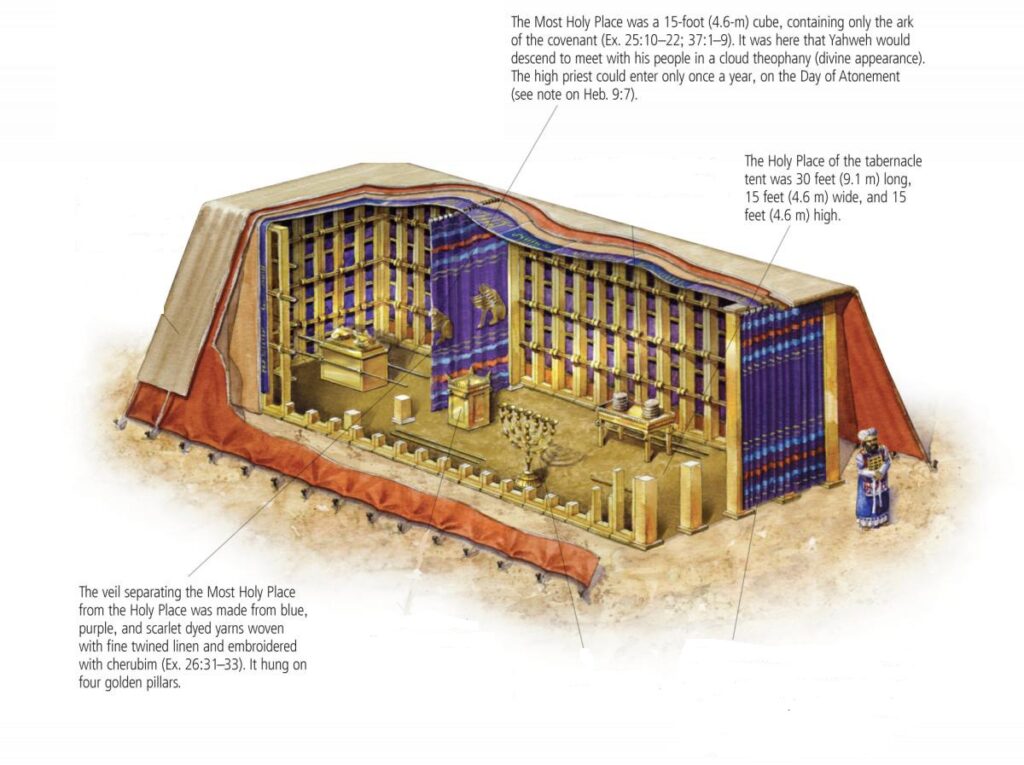Part 1 of this series is here.
I want to tackle Hebrews 7:25, which in the minds of many serious readers immediately translates to The Courtroom.
Consequently, he is able to save to the uttermost those who draw near to God through him, since he always lives to make intercession for them.
The first half of that verse
“From the uttermost to the guttermost.” That’s a nonsensical saying, but if you grew up Independent Baptist like I did, it might sound familiar. It’s ostensibly from the first part of this verse, to tell us that Jesus can save anyone, the highest and the lowliest.
That’s not what this verse is about, or even that word.
That word “uttermost” means “completely, wholly,” or in Biblical language “perfectly.” (I’ve written extensively in my subscriber emails about what the word “perfect” means in the Bible, so I won’t belabor that here.)
But there is also that word save.
“Save” can mean three things:
(1) Rescue. The disciples in the boat in the storm said, “Lord save us from perishing!” (This is being saved from.)
(2) Preserve/keep. In 2 Timothy 4:18 Paul said, “And the Lord shall deliver me from every evil work, and will preserve [save] me unto his heavenly kingdom . . .” (This is being saved to.)
(3) Heal / make whole. The woman with the issue of blood said to herself about Jesus, “If I may but touch his garment, I shall be saved.”
If we are going to be “saved” completely, wouldn’t that mean all three of these things? Rescued from something/someone, kept/preserved for something/someone, and made whole. Surely it would.
And how does that happen without relationship? The more I grow as a person, as a student of the Word, and as a trauma-informed coach, the more I deeply understand that we are wired for relationship and relationship is what salvation is about.
It is not simply salvation from. It is salvation to, with healing and wholeness as part of the package. And notice who it is that He saves. Those who draw near to God through Him.
I can’t even tell you how many people I’ve heard from who are terrified to draw near to God. From what they understand, God is like their abuser. He presents one way in church and another way at home. He is far more about punishing and judging than about loving and caring.
So, they think, if we approach God the Father at all (and they’d rather not) we have to approach Him hiding behind Jesus, as it were, so He can do His intercession.
That comes next.
The “intercession” of Jesus
In the Courtroom picture most people see when they read this verse, our Defense Lawyer, the Lord Jesus, is constantly pleading the case of His redeemed people before the Great Judge, God the Father, who has rightly condemned us for our sins and crimes.
Charles Wesley appears to have felt this same way, so this belief obviously has a long history. Here’s a Wesley song I have loved, and indeed there is much to love about it:
Arise, my soul, arise, shake off thy guilty fears.
The bleeding Sacrifice on my behalf appears.
Before the throne my Surety stands—
my name is written on His hands.
He ever lives above, for me to intercede;
His all-redeeming love, His precious blood to plead,
His blood atoned for all our race
and sprinkles now the throne of grace.
Five bleeding wounds He bears, received on Calvary;
they pour effectual prayers, they strongly plead for me.
“Forgive him, O, forgive,” they cry,
“Nor let that ransomed sinner die!”
The Father hears Him pray, His dear Anointed One;
He cannot turn away the presence of His Son.
His Spirit answers to the blood,
and tells me I am born of God.
My God is reconciled, His pardoning voice I hear;
He owns me for a child, I can no longer fear.
with confidence I now draw nigh,
and, “Father, Abba, Father,” cry.
I want to draw special attention to verse 3:
Five bleeding wounds He bears, received on Calvary;
they pour effectual prayers, they strongly plead for me.
“Forgive him, O, forgive,” they cry,
“Nor let that ransomed sinner die!”

The image presented in that song verse is a mashup between Hebrews 7:25 and The Courtroom. What else could Jesus be doing, Wesley apparently thought, how else could He be interceding, except by continuing to ask the Father to forgive us, to refrain from harming us? Forever and ever.
Wesley’s song is actually a little better than The Courtroom, because at least it does end with the Father loving us, whereas The Courtroom ends with the Father just letting us go. (Any love or relationship has to be represented through a different extended metaphor.)
But it is essential to recognize that the very, very long context for Hebrews 7:25 is the priests and the priestly system. It absolutely does not make sense to lift what is obviously a Temple metaphor right out of its context and plop it into a courtroom.
Stay in the Temple, my friends.
Hebrews is all about the Temple, not the Courtroom at all. So this intercession needs to be viewed in THAT scenario.
As a brief refresher, a basic view of the Temple/Tabernacle area is laid out in three parts:
(1) the outer courtyard, where all Israelites could go,
(2) the Holy Place, where the priests served every day, and
(3) the Holiest Place (aka Holy of Holies), where the high priest entered once a year on the Day of Atonement.

A cutaway diagram of the tabernacle, which was the portable temple for the Israelites during their days of wandering. When the temple was built, the interior looked like this too.
So, what does “intercession” really mean?
As I’ve been studying through Hebrews this time, I zeroed in on the Greek word translated “intercession.” What does it really mean?
Actually it means “to communicate with someone about someone else,” whether positive or negative. This word is used 5 in the New Testament, and in 2 of them, the “intercession” is negative toward the object of discussion (Acts 25:24 and Romans 11:2). Three of them are positive, including this verse in Hebrews and Romans 8:27 and 34.
So what we see here is that Jesus is engaging in positive communication with the Father about us, rather than “pleading our case” before a judge.
When my mind was freed from The Courtroom, I pictured this intercession of Hebrews 7:25 going on in the Temple scenario. Right away I saw Jesus at the juncture between the Holy Place and the Holiest Place.
Why did my mind immediately go there? Because I remembered that when He died, the heavy curtain (the “veil”) to the Holy of Holies was torn in two (Matthew 27:51). Hebrews 10:19-22 tells us that the tearing of His own flesh was the tearing of this veil—so we can come to the Father “through Him.”
And I knew that when He rose again, He sat down, in joyful victory, at the right hand of God the Father (Hebrews 1:3,13, 8:1,10:12,12:1-2; Romans 8:34; Psalm 110:1,5; Psalm 16:11).
I pictured Him there, with that heavy curtain out of the way, communing with the Father, on His throne of grace (Hebrews 4:16), about us. He smiles at the Father about us. The Father smiles back, about us.
The intercession of our Lord Jesus Christ with the Father for us is not about staving off judgment but is about joyful relationship.
Welcome to the Holiest Place
Our Lord Jesus is there at the entrance to the Holiest Place, all the time, not just once a year. Because He has accomplished ALL, He is there as our Great High Priest, welcoming us, providing our opportunity to be “at one” with the Father.
Because of that perfectly aligned, never-in-opposition communication between the Father and the Son, we are now provided the opportunity to walk right in to that Holy of Holies. We come straight to the place of the Lord God most high, not brashly like fools, but boldly, like dearly loved children (Hebrews 4:16).
Andrew Murray, in his commentary on Hebrews, posits that when He lived on earth, Christ’s life was comparable to being in the Holy Place, where the priests went every day to do their regular holy duties. But upon His resurrection, He entered into the Holy of Holies with His glorified body, opening up to us the way to have meaningful, joyful relationship with the Father.
It is a relationship far beyond what the Old Covenant people of God could have imagined.
The Scriptures never present a legal Courtroom to represent our salvation. The Scriptures present the Temple. Through the blood of Jesus, we who trust in Him have been purified. We can approach the Father on His throne of grace, whose arms are outstretched for us in genuine love. There, we can be at one with Him. He doesn’t need to be “reminded” that we are forgiven.
And indeed, there is so much more to our salvation than forgiveness.
This is the metaphor that represents not only that rescue from, but also the keeping to: that is, the joyful relationship with the Lord that can encompass our entire Christian life.
***
I know this is a controversial series. I welcome mutually respectful dialogue, including pushback, in the comments. I want my thinking, as well as that of my readers, to continue to be sharpened.
This article contains a whole lot of Scriptures in parentheses. When other writers do that, I look up those Scriptures, in part to see if they really do support the argument being made. I encourage you to do the same.
Part 3 of this series is here.
***
Go here to download your free Guide, How to Enjoy the Bible Again (when you’re ready) After Spiritual Abuse (without feeling guilty or getting triggered out of your mind). You’ll receive access to both print and audio versions of the Guide (audio read by me). I’m praying it will be helpful.

Ses like many people forget that sanctification is what the Christian is currently going through. Justification has already happened when we accepted the offer of salvation. The courtroom analogy ooverfocuses on the Justification part and it doesn’t even assign the Holy Spirit to be the parole officer? And the Holy Spirit isn’t referred to be that exactly either.
Haha! Parole officer. Good one!
That’s one of the many problems with The Courtroom–it’s only about that moment of “justification”–but the Courtroom metaphor doesn’t even make us right with God. It only changes the decree about our eternal destiny. If it made us right with God, we would be sitting with Him rather than walking out of the courtroom away from Him.
Thank you Rebecca. 🙂
I haven’t words for the comfort, the relief these thoughts bring.
All of this is a new and welcomed way for me to view my heavenly mediator, JESUS.
Thank you for sharing this in this season of advent when God’s ultimate desire for intimate Relationship with us was so evident in the incarnation.
Oh, so very true. Yes. Thank you, Quietrunner.
Hebrews and the OT come to the rescue again to clarify our understanding!
God has not left us as orphans, to figure out from whatever example a human being can dream up to explain things to us. The explanations are right there in His Living Word, telling us he loves us.
It is relieving for all three of the sense of meaning for the word save to be shown vividly in the Temple Scene – to be saved completely – YES!
(The scene in Revelation 22:1 of the River of Life, flowing from the Throne of God, comes to my mind to show that “saved completely” concept, too, I believe.)
Thank you, Rebecca!
Beautiful! Thank you, Dolla!
A blessing and an encouragement!! Many thanks!
Love it.
As of late, God has been transforming my mind to begin to see God/Jesus as One, as for most of my life Ue has seemed as two very separate entities. God reconciled the world to Himself, through Jesus. God died on the cross.
Anyway… this idea of Jesus standing at the throne of God, And interceding for us, is a difficult picture for me. I LOVE Hebrews. Ranks as fave next to Ephesians. I’m beginning to see that much of Hebrews is written for the purpose of helping the Hebrew people understand who Jesus was, in light of their temple practices.
Perhaps some of it has a more an illustration so they could understand, and less of an actual reality.
Just putting some thoughts out there.
I mean. In reality, God is a spirit being, and He made Himself flesh so we could see Him and know Him.
So does the human, Jesus, stand before the throne of a spirit and an intercede for us? Or is this meant to be a picture for the Jews that Jesus became the forever high priest instead of their human-priests?
Hebrews does say many times that our risen Lord Jesus was seated at the right hand of God the Father after His finished work. I would say that the spiritual world is actually more “real” (lasting, eternal) than the physical world. The entire Tabernacle/Temple setup in the OT was given as a shadow of the forthcoming realities, a representation to help us understand. (I also think no one who puts forward the Courtroom metaphor would claim there was an actual courtroom in the spirit realm–just that it’s a metaphor.)
I understood many passages better when I learned a second language. It got me to look at the Bible in a new way.
Thanks so much for your work!
Re: “In Matthew 16:25 Paul said, “And the Lord shall deliver me from every evil work, and will preserve [save] me unto his heavenly kingdom . . .”
Biblia.com’s NIV quotation of Matthew 16:24-25, “24 Then Jesus said to his disciples, “Whoever wants to be my disciple must deny themselves and take up their cross and follow me. 25 For whoever wants to save their life will lose it, but whoever loses their life for me will find it.”
Is this quotation of Paul from 2 Timothy 4:18?
Yes! That was a pretty crazy brain glitch of mine, to think that Paul was talking in the book of Matthew. I din’t even know where that came from. Thank you for catching that.
Great series! There is so much wrong with the courtroom metaphor, it literally takes a book to unravel the distortions. And the idea that God has to see us through a lens that Jesus provides makes me shudder. Jesus is our way TO the Father, not our way of avoiding Him.
Yes, so perfectly stated.
AMEN AND AMEN! Nothing to discuss- I totally agree.